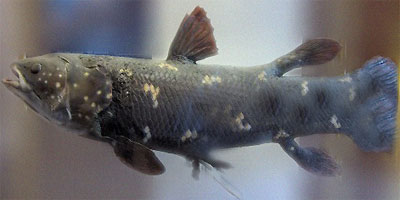Population of prehistoric deep-ocean coelacanth may go the way of the dinosaurs.
A harbor project in Tanzania may put a population of coelacanth at risk, reports Nature News.
A port development plan put forth by the Tanzania Ports Authority recommends building a deep-water harbor in Mwambani Bay near the Kenyan border. The port would accommodate large container ships which it hopes will bring economic development to the impoverished region. But the project could “will probably wipe out the local coelacanth population” according to a 2008 assessment by the Tanzania Natural Resource Forum (TNRF), a local environmental group, due to increased ship traffic, sedimentation, and other ecological changes.
 Latimeria chalumnae |
The coelacanth is famous for its prehistoric appearance, with heavy body armor, a stocky body, and origins going back tens of millions of years. The creature
was believed extinct since the age of the dinosaurs until an individual was captured off the coast of Southern African in 1938. Since then the fish has been found along the south-east African and in Indonesia.
Generally found at depths exceeding 300 feet (90 m), coelacanths occasionally show up in fish markets in Africa and Indonesia, usually captured as by-catch by fishermen seeking deepwater species. The critically endangered fish is believed to be sexually mature at 20 years and live to 80-100 years old.
TNRF says the Mwambani Bay port project may be unnecessary. A nearby port at Tanga Bay is only half utilized and upgrading this existing port would only be a fraction of the cost of new construction at Mwambani Bay.

Mwambani Bay
References:
Quirin Schiermeier (2009). Harbour threat for coelacanths. Published online 23 February 2009 | Nature | doi:10.1038/4571063a
Tanzania Natural Resource Forum, Arusha (2008). Does Tanga need a new harbour at Mwambani Bay?